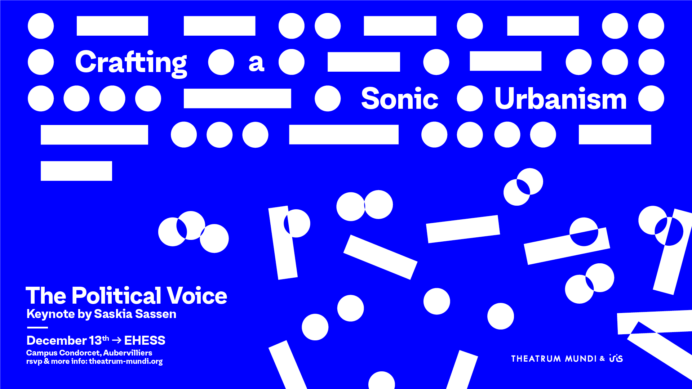Crafting a Sonic Urbanism: the Political Voice
Attention is turning more and more to urban sound as a material to design with, as a site of conflict, as a medium through which to understand the urban environment, and so on. Crafting a sonic urbanism seeks to look beyond the soundscape as an object and bring together research and creative practice that reveals how sonic concerns and methods could shed new light on political, cultural, and social formations in the city.
This colloquium invites both scholars and practitioners to present research, or works of sonic or spatial creation. You can find the full call for proposals here.
Following the first conference in 2018 exploring sonic urbanism in its broadest interpretation, the second iteration will focus on the ways that the voice / voices and their enmeshments with architecture, infrastructure, and technology are understood in the fields that both analyse and design urban life in their political dimension. To be politically engaged is to have one’s voice ‘heard’ in the public space. How and where, though does this hearing happen? Whose voices are heard, both in the street and on the political stage? What is the role of architecture in amplifying or indeed diminishing the audibility of difference voices?
Programme
The day will be organised in two events. A colloquium (free, sign up mandatory) and an evening conference (free, sign up recommended).
COLLOQUIUM — 9.30-17.00
09.30-09.45 — Welcome and opening remarks
John Bingham-Hall
Director
Theatrum Mundi
Arnaud Esquerre
Director
IRIS (EHESS)
09.45-11.00 — COMPOSING THE VOICE
Duncan MacLeod
Assistant Professor of Music
University of Nottingham
→ The Cries of London
Jonathan Packham
DPhil Student
Oxford University
→ Lin Chi-Wei’s Tape Music: Spatial Scoring, Voicing Identity
Fani Kostourou
Researcher
Theatrum Mundi
Dimitri Szuter
Fellow
Theatrum Mundi & Evens Foundation
→ The voice of and on a Parisian territory in transition
Chaired by John Bingham-Hall, Theatrum Mundi
11.15-12.30 — MEDIATING VOICES
Fabien Cante
Teaching Fellow
University College London
→ Post-conflict soundings and radiophonic repair in Abidjan, Côte d’Ivoire
Eleni Ikoniadou
Senior Tutor in Visual Communication
Royal College of Arts
→ Fugitive Voices
Gregoire Chelkoff
Professeur Enseignant chercheur
Cresson / Ecole Nationale Supérieure d’Architecture de Grenoble
→ Les voix de la ville : effets sonores, espaces construits et ambiances urbaines
Chaired by Lola San Martín Arbide, EHESS
12.30-13.30 — Pause déjeuner
13.30-14.00 — PERFORMANCE
Jessica-Maria Nassif
Designer
→ Mix, Match and Start From Scratch
14.00-15.15 — ORAL CULTURES
Eric de Visscher
Andrew W.Mellon Visiting Professor
VARI (V&A Research Institute), Victoria and Albert Museum
→ Can museums reveal themselves as platform for a new sonic urbanism?
Tyler Sonnichsen
Lecturer
Central Michigan University
→ Punk, Oral History, and the Voice of the Revanchist City
Ella Finer
Adjunct professor, Performance Studies
Syracuse University, London
→ A Politics of Resonance: the Commons and the Square
Chaired by Gascia Ouzounian, Oxford University
15.30-16.45 — VOCAL CONTESTATIONS
Naama Meishar
Teaching Fellow
Technion – Israel Institution of Technology
& Talia Margalit
Senior Lecturer
School of Architecture, Tel Aviv University
→ Routine, Cry and Demand in southern Tel Aviv: Peddlers, Asset owners and Developers Voice objections to the Planning Committee
Laudan Nooshin
Professor and Head of Music Department
City, University of London
→ Understanding the Sensory City: Tehran’s Contested Voicescapes’
Tom Western
Marie Curie Fellow
Faculty of Humanities, University of Oslo
→ Sonopolis: Refugee Feedback and Noisy Citizenships in Athens
Chaired by Justinien Tribillon, Theatrum Mundi
16.45-17.00 — Closing Remarks by Richard Sennett
CONFERENCE — 18.00-20.00
Projection du film Voi[e,x,s] et présentation par Alexandra Lacroix
Metteuse en scène
Cie MPDA – Alexandra Lacroix
Saskia Sassen
Robert S. Lynd Professor of Sociology
Columbia University
→ Does the City have speech?
In asking “Does the city have speech?”, Saskia Sassen (2013) provides the stimulus for this colloquium. The city, she argues, is still “a space where the powerless can make speech, presence, a politics”, but furthermore, the “interactive deployment of people, firms, infrastructures, buildings, projects, imaginaries, and more, over a confined terrain, produces something akin to speech” (2013, 211). In other words, “the city talks back”. As architectures and active bodies coalesce in particular times and places in the city, and in particular ways, ‘resistances and enhanced potentials’ emerge that change the meaning of intended acts like design, or of chance forms of encounter. “Rush hour in the city is a process where we bump into one another, rip off a button here or there, step on one another’s feet. Yet we know none of these actions are personal in city’s center at rush hour, unlike in the neighbourhood, where they would all be provocations” (Sassen 2013, 214). This kind of speech is not only sonic, but any act that changes meaning or that communicates – something that can be done both by people and by the city they speak through and within. But what if we returned to the acoustic material at the base of this concept? How, literally, do our own utterances become translated via the language of the cities that are their containers? How do the acoustic resistances and acoustic potentials of architectural space speak through and transform voices themselves.
Chaired by Sylvain Bourmeau
Directeur AOC
Professeur Associé à l’EHESS
Producteur sur France Culture
